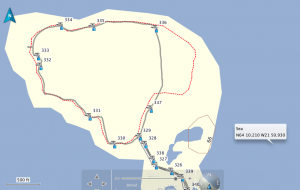While in Reykjavik, I toured some of its art galleries and museums. Some highlights:


Hanging in the entry at Hafnarhus was The Icelandic Love Corporation's "Sokkabuxnavehur"/Tights-web.
An inventive use of panty hose!
There was also a wonderful installation "Knitting House" by Elin Ruin and the New Beauty Council.


"Knitting House" recreated the most common type of apartment in Husby, a suburb of Stockholm, Sweden. The apartments were a standardized prefab housing project built in 1974. Women knitted an exact replica of the apartments at 75% scale. Visitors can walk inside, stepping over a steel support structure to enter all of the rooms. Wonderful details and textures that include stains, wallpaper patterns, tiles, knobs, fixtures, all in muted hues.
On Viðey Island, I visited Richard Serra's "Milestones". I felt like I was on a pilgrimage as I walked from station to station, once again tracking the walk using my GPS.

"Milestones" also called "Áfangar", spans the entire western part of Viðey, an island in Reykjavik's bay. The piece comprises nine pairs of basalt columns, a reference to the geology of the island.


The columns are placed at the same elevation on the periphery of the island: one column of each pair stands nine metres above sea level, the other at ten metres. One pillar of each pair is four metres in height and the other three metres, so that the tops of the pillars are at 13 metres above sea level. The distance between each pair of pillars depends upon the gradient of the ground. All the pillars are visible from the highest point on west Viðey, at 18 metres above sea level.

Also on the island is Yoko Ono's "The Imagine Peace Tower" conceived as a beacon to world peace. The work is in the form of a wishing well on which the words "Imagine Peace" are inscribed in 24 world languages. Out of the well emerges a strong, tall tower of light.
On Oct 9, 2007 the work was dedicated to the memory of John Lennon, on his 67th birthday. Every year the Imagine Peace Tower is lit from October 9 (Lennon's birthday) to December 8 (the day of his death). In addition the tower is lit from the winter solstice to New Year's Day and during the first week of spring. The electricity for the light comes entirely from Reykjavik Energy and is generated from geothermal power.
On the Snaefellsnes peninsula, I visited Roni Horn's installation, "Library of Water" http://www.libraryofwater.is/landing.html in the coastal town of Stykkisholmur. It is located in a former library building that stands on a promontory overlooking the town and ocean.


The "Library of Water" is a constellation of 24 glass columns that contain water collected from ice of some major glaciers around Iceland. The glass columns reflect and refract light onto a rubber floor embedded with Icelandic and English words that relate to weather.
And finally back in Reykjavik, the i8 gallery (my favorite gallery in Reykjavik) featured the work of artist, Egill Sæbjörnsson who experiments with elements of sculpture, animation and sound that interact in a playful and inventive way.






















































